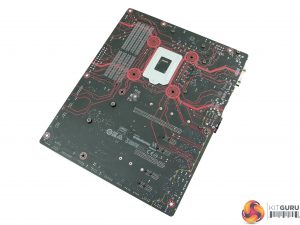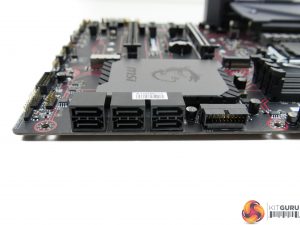The MSI Z270 Gaming M3 is equipped with a black, grey, and red colour scheme with the latter being deployed as multiple lines that form a circuitry type of appearance. Hints of grey on the heatsinks and rear IO cover will appeal to many potential customers.
Other than MOSFET phase doubles/drivers, nothing else of note is mounted on the rear of the motherboard PCB.
Mounted close to the 24-pin power connector and two 4-pin fan headers are the board’s four DDR4 DIMM slots. MSI lists support for DDR4 frequencies in the region of 3800MHz via overclocking. However, such speeds will be heavily tied to the CPU’s IMC strength and the BIOS profile tuning.
16GB DDR4 DIMMs can be installed, making this motherboard useable with up to 64GB of memory. I like MSI’s on-PCB text that outlines which DIMM slots should be used first for those with two-stick kits.
Being an LGA 1151 motherboard, the MSI Z270 Gaming M3 is compatible with Intel’s 6th Generation and 7th Generation LGA 1151 processors such as the Core i5-6600K, Core i3-7350K, and Core i7-7700K.
A total of ten power delivery phases are allocated for the CPU and additional components, such as the iGPU. MSI uses components falling under the vendor’s ‘Military Class V’ branding, which include Titanium-based chokes and ‘dark’ capacitors.
A well-built heatsink is deployed on top of the hot-running MOSFETs, which is very pleasing to see even if LGA 1151 processors are not in danger of overloading the power delivery components.
Six right-angled SATA 6Gbps ports are all provided by way of the Z270 chipset. Sat next to those ports is one of the board’s two internal USB 3.0 5Gbps headers for connection to a case. Its right-angled orientation is ideal for users trying to hide the fat USB 3.0 header cable when trying to conduct cable management.
All six SATA 6Gbps ports can be used alongside a pair of M.2 PCIe SSDs, though M.2 slot 1 steals its SATA 6Gbps link from SATA port 1 and M.2 slot 2 steals its SATA 6Gbps link from SATA port 6. A pair of M.2 SATA SSDs will render two of the physical SATA ports unusable.
I think MSI’s lane allocation for SATA connections is very smart. It is highly unlikely that a user buying this type of motherboard will need more than six SATA devices in total, or six plus two M.2 PCIe SSDs. MSI also deserves credit for pages 32 and 33 in its motherboard manual which give a clear interpretation of possible storage device connections. This reduces the installation complexity to novice users with lots of drives.
Two M.2 slots both support PCIe NVMe SSDs with up to 32Gbps Gen 3 x4 link speeds, as well as SATA 6Gbps SSDs. The slots are compatible with Intel Optane technology using the 3D XPoint-equipped M.2 SSD available.
Bandwidth sharing means that using the lower M.2 slot renders the second full-length PCIe expansion slot unusable. Disabling of the four PCIe x1 expansion slots may have been an alternative option. However, those x1 slots are likely more valuable to users at this end of the market than the high-bandwidth PCIe 3.0 x4 expansion slot in its full-length form.
Positioning of the M.2 slots is fine. The upper one will receive incidental airflow from an air CPU cooler while the lower slot is far enough from a graphics card to reduce the likelihood of overheating. However, the positioning does mean that an M.2 SSD with an ugly green PCB will be highly visible.
No SATA-Express or U.2 are not negative points for a motherboard with this target audience, especially seeing as the former is practically dead and the latter can be provided through an adapter.
MSI has clearly designed this board for users not wanting multiple graphics cards as that point is confirmed by the lack of SLI or high-bandwidth CrossFire compatibility. All sixteen PCIe 3.0 lanes from an LGA 1151 processor are delivered directly to the uppermost PCIe slot for a graphics card. That full-length slot also receives steel shielding, that MSI refers to as Steel Armor, to enhance its strength.
The second full-length PCIe slot runs at Gen 3 x4 bandwidth with lanes coming from the Z270 chipset, making it suitable for use with devices such as a high-speed SSD, a high-bandwidth NIC, or a RAID card. However, its lanes are shared with the lower M.2 slot and it is rendered unusable if a SSD is installed in that M.2 location.
Further expansion options are provided by the four PCIe 3.0 x1 slots, three of which will be usable alongside a graphics card. These are ideal for low-bandwidth devices such as WiFi and sound cards.
The usual set of headers is found along the board’s bottom edge, in addition to a second internal USB 3.0 5Gbps header and the 4-pin RGB connection.
MSI’s Audio Boost 4 system is based around the popular Realtek ALC1220 audio codec. Nippon Chemicon capacitors are used in addition to multiple EMI-reducing steps and a headphone amplifier. Nahimic 2 software is supported.
Peripherals connectivity is taken care of by two USB 2.0 ports and a legacy PS/2 connector. Four red-coloured 5Gbps USB 3.0 Type-A ports are delivered through the Z270 chipset. MSI uses a PCIe 3.0 x2 ASMedia ASM2142 chipset to provide 10Gbps USB 3.1 Gen 2 connectivity in Type-A and Type-C form.
DVI-D (single-link) and HDMI provide video output for the iGPU. The DVI connector can operate up to 1920×1200 at 60Hz, while the HDMI port is capable of 4K at a low refresh rate (30Hz or below, depending on the processor) or up to 2560×1600 at 60Hz. There is no 4K60-capable video output with this motherboard, which is unlikely to be missed by gamers.
Gigabit Ethernet is delivered by a Killer E2500 controller that is compatible with Killer’s network-management software. MSI also includes a free subscription of WTFast gaming network software. Gold plating is used on the audio connectors to enhance signal quality.
Six 4-pin fan headers are distributed across the motherboard, which is excellent for a mid-priced offering. Four of the headers are within reach of the CPU socket and they all feature an ability to provide DC or PWM control to fans.
The board’s sole software-controllable 4-pin RGB header is found on the bottom edge, next to a pair of 4-pin fan connections.
 KitGuru KitGuru.net – Tech News | Hardware News | Hardware Reviews | IOS | Mobile | Gaming | Graphics Cards
KitGuru KitGuru.net – Tech News | Hardware News | Hardware Reviews | IOS | Mobile | Gaming | Graphics Cards













Muy buena review